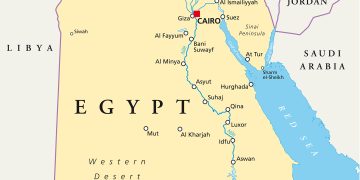Another case of the latest UK MAIB Safety Digest highlights lessons learned concerning an incident in which ship’s high speed and close proximity to a chain ferry caused the vessels to interact.
The incident:
A passenger/ro-ro cargo ship was inbound to a regular port of call. It was daylight with light winds and good visibility. The bridge was manned by the master, an OOW and a helmsman. The port was situated in a large estuary and was entered on a north-westerly heading by means of a narrow channel that passed between two headlands. A strong ebb tidal stream was common through the entrance, as was the case at the time of the accident. A speed limit of 10 knots was imposed, and a sectored light was provided to assist navigation through the narrow entrance.
A chain ferry, which operated between the two headlands, was moored in its out-of-service position a few metres off the southern slipway. After the ship had entered the approach channel, the master took the con and reduced the ship’s speed over the ground (SOG) to 10 knots. He then altered course with the aim of turning onto the centre of the channel marked by the white sector of the leading light. As the ship passed the chain ferry, the latter started to move laterally south-east. The ship’s master then applied starboard helm to initiate a planned turn to starboard. As the ship passed over the chains of the chain ferry, the chain ferry stopped and then moved laterally northwest before coming to rest.
The ship’s high speed and close proximity to the chain ferry had caused the vessels to interact, which had resulted in the chains of the chain ferry being lifted. The ship had, in fact, tracked south of the white leading light line. This, coupled with the low height of tide and the resulting squat effect on its draught, had led to the ship making contact with the seaward chain of the chain ferry.
The ship sustained some minor damage to both of its rudders, a propeller tip and the underside of its skeg. The seaward chain of the chain ferry parted as a result of the accident, requiring the chain and its associated hydraulic motor to be replaced.
Lessons Learned
1. Given the bridge team’s familiarity with the ship having previously entered the port without incident at various states of tide, traffic and weather, their main focus was on preventing the ship from grounding on a shallow sandbank located to the north of the leading light line. They achieved this by ensuring a minimum pre-determined radar range off the northern headland; the fact that this resulted in the ship tracking south of the leading light line generated little concern.
Navigational best practice would have been to turn the ship onto the leading light line as early as possible. Then, by visually monitoring the sectored light and by using radar parallel indexing, the ship’s heading would have been adjusted to maintain a track that followed the leading light line until it was necessary to turn the ship to starboard, ensuring that it was clear of all identified dangers, including the shallow sandbank to the north.
In view of the variable nature of tide, traffic and weather, a key element missing from the ship’s passage plan was information on the extent to which the ship could safely deviate from the intended track, given the prevailing conditions. What safety margins are you working to? Are there others you should be taking account of ?
2. After handing the con to the master, the OOW had little further involvement in the ship’s navigation into the port. The master did not inform the bridge team of his intended track, and assumed that the OOW would alert him should the ship deviate from the normal track. Without a full understanding of the master’s intentions and no proper consideration of the extent to which the ship could safely deviate from the normal track, the OOW was restricted in the practical assistance he could provide to the master.
3. A bridge team that is comprehensively briefed and has a clear understanding of the plan is better prepared to maintain good situational awareness, and to immediately address developing hazardous situations.
4. The imposed speed limit of 10 knots was intended to refer to speed through the water. Due to the prevailing strong ebb tidal stream, the ship’s SOG of 10 knots corresponded to a speed through the water of 14-15 knots, which was needlessly high and caused unnecessary squat and interaction.
Interaction between two vessels passing in close proximity can occur in any depth of water, but it is intensified by the effect of shallow water as squat amplifies the pressure difference along the hull. Similar to squat, the extent of interaction is proportional to the square of the ship’s speed through the water. Travelling at 10 knots rather than 14-15 knots would have halved the ship’s interaction with the chain ferry.
Source & Image credit: UK MAIB






























































